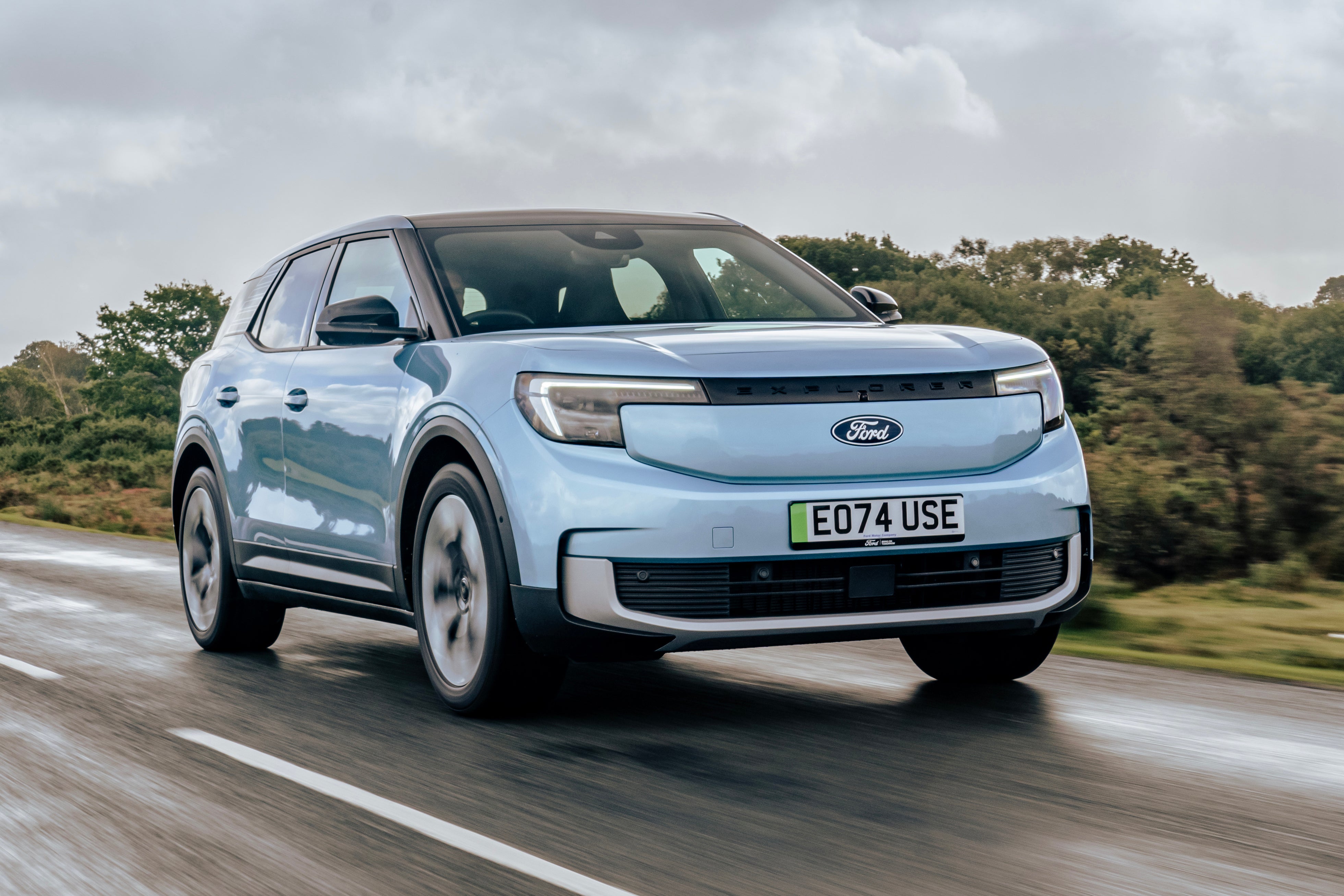Ford Explorer Review 2025: Price, specs & boot space
Written by Keith WR Jones
Quick overview
Pros
- Can travel up to 374 miles between charges
- Fine handling with plenty of grip
- Lots of standard kit
Cons
- Expensive without feeling special
- Lacks some rivals’ practicality
- Fiddly haptic and touchscreen controls
Overall verdict on the Ford Explorer
"Familiar as it is to Americans, the Ford Explorer name is relatively unknown to British car buyers. A version was briefly sold here in the late 1990s — quenching its 4.0-litre petrol engine’s thirst proved ruinous for those hooked by its chrome-garnished, helluva car for the money appeal. Perhaps strange, then, that Explorer’s the name Ford’s chosen for its electric SUV, engineered in Germany for European tastes. Regardless of its badges, the result is handsome and contemporary"
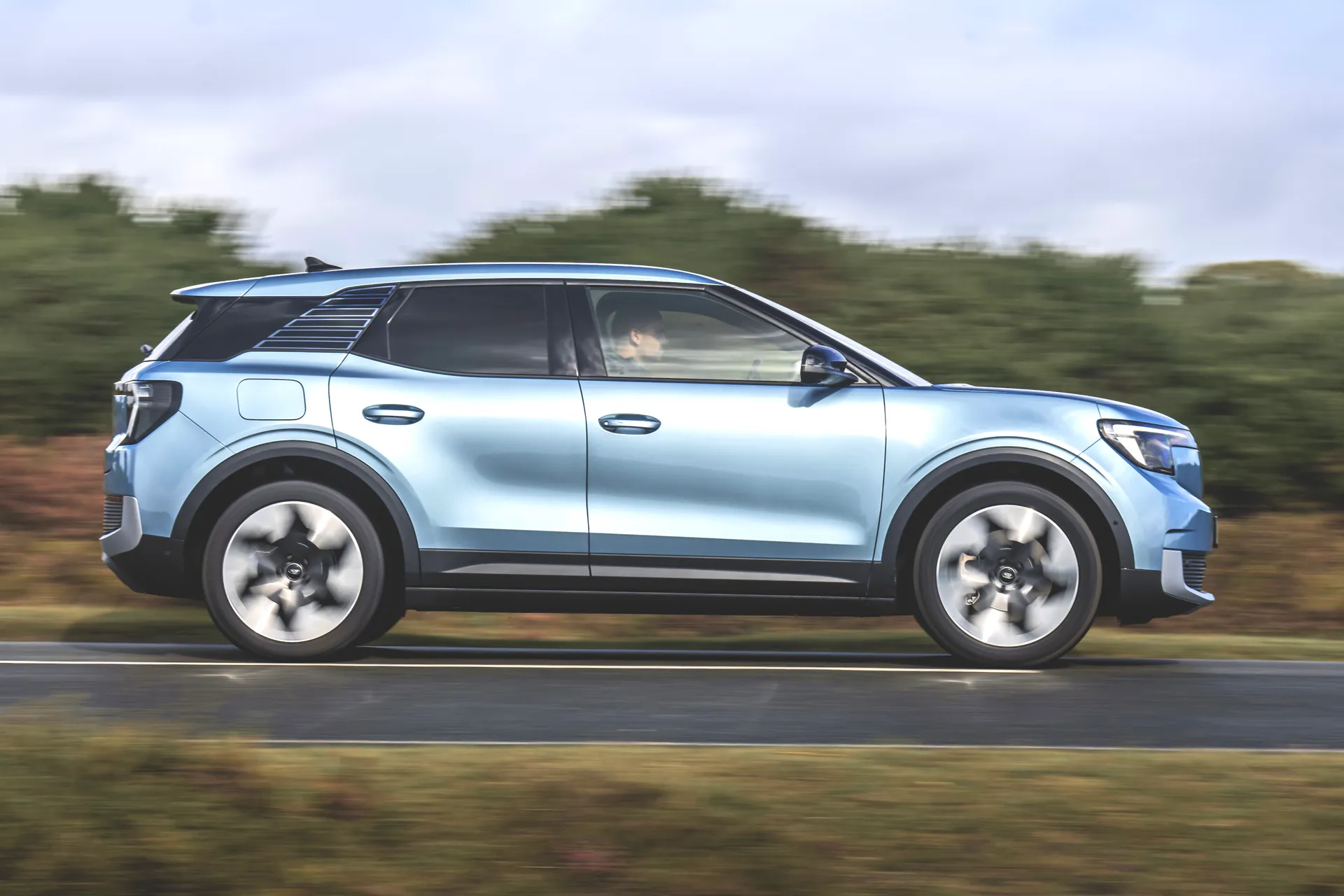
This isn’t the company’s first battery-powered SUV rodeo, of course as the slightly larger, North American-built Ford Mustang Mach-E has been on sale here since 2021. Yet the Explorer — and the forthcoming Ford Capri — is based on a completely different set of underpinnings.
Rather than developing an EV platform from scratch, Ford bought in the Volkswagen Group’s MEB architecture, including batteries, motors and electronics, although the suspension has been rejigged in order to make it feel more familiar to existing customers swapping from a Focus or Kuga.
All of this makes the Explorer a cousin of the Volkswagen ID.3 and Cupra Born electric hatchbacks, along with direct SUV rivals such as the Volkswagen ID.4 and Skoda Enyaq.
It’s worth pointing out that the ID.4 and Enyaq are longer overall than the Explorer, to the tune of around about 190mm, but because the distance between the front and rear wheels (the wheelbase) is unaltered, passenger space inside is on par.
Great, so it’s just as roomy yet easier to park. What’s the catch? Reduced boot space. That’s down to the shorter rear overhang — the amount of bodywork protruding beyond the back wheels. Less bodywork equals less space inside it, shrinking the Explorer’s boot to 470 litres. The Enyaq’s boot is 585 litres, but, interestingly, even the Ford Explorer’s more closely sized rival, the Renault Scenic, boasts 545 litres of carrying capacity.
The Scenic has another advantage. It starts from £37,495, while the cheapest Ford Explorer is £39,795. It’s also pricier than the larger entry-level Enyaq, while more expensive versions of the Explorer will cost you as much as some versions of the Kia EV6 and Tesla Model Y, both of which are more capacious than the Ford.
Expensive, yes, but in fairness, the Ford Explorer is competitive in other ways. It’s very well equipped for one thing and it has a great battery range. The smallest battery option — the 52kWh Standard Range rear-wheel drive (RWD) — will do around 250 miles on a single charge, which is decent. Meanwhile, the 77kWh Extended Range RWD, with its bigger battery, can chalk-up an official 374 miles on one charge. That’s up with the best you can buy for the money. With a healthy 286hp it’s quick, too – 0-62mph takes 6.4 seconds.
Fancy trading battery range for more speed? Then there’s the 79kWh Extended Range all-wheel drive (AWD). Power’s sent to all four wheels by dint of having not one but two motors — the extra one nestled under the bonnet — together producing 340hp. The official range drops to 329 miles but it’ll tick off 0-62mph in a hot-hatch-bating 5.3 seconds.
Looking for a used car for sale? We've got 100s of Ford Approved Used Cars for sale for you to choose from.
Is the Ford Explorer right for you?
Well, there’s no doubt the Ford Explorer has some strong points that make it worth considering, particularly if you love its clean, contemporary styling. It handles decently, offers punchy performance, an impressive electric range, plus it’s well equipped.
That all has to be weighed against its relatively high price. It’s expensive compared with its chief rival, the Renault Scenic, itself an exceptionally good all-rounder that’s also more comfortable and more practical than the Explorer.
That’s not all. The Explorer’s list price is so lofty you can also pick up cars in the next size bracket for similar — or even less money. Those include the Skoda Enyaq as well as other great alternatives, including the Kia EV6 and Tesla Model Y. And the Model Y, don’t forget, has a USP — access to Tesla’s excellent Supercharging network.
Sure, the Ford Explorer is worthy of being on your shopping list, but we’d stop short of saying it’s a must-have.
What’s the best Ford Explorer model/engine to choose?
We haven’t tried the cheapest 52kWh Standard Range because it isn’t on sale yet — deliveries won’t begin until early 2025. Even so, having tried the 77kWh Extended Range RWD, we reckon that’s going to be the version most people buy.
Why? Because it has the best electric range of between 354-374 miles, depending on trim level, which competes well with the equivalent Renault Scenic Long Range (379 miles). Plus if you stick with the cheapest Select trim it keeps the price to a whisker under £46,000 — although that’s still a lot pricier than the equivalent Scenic.
What other cars are similar to the Ford Explorer?
Most obviously the Renault Scenic. It’s an all-electric SUV with similar dimensions on the outside. The Scenic is also available with a great electric range, but, as we’ve said, like-for-like it’s better value. And not only does it undercut the Explorer on price, it’s a better, more practical car overall, too. Other similarly sized electric SUVs you could consider include the Kia Niro Electric and Skoda Enyaq — and both start at well under £40,000.
If your budget goes further — to around £45,000 — then you should definitely look at cheaper versions of the Hyundai Ioniq 5, Kia EV6, Volkswagen ID.4 and Tesla Model Y, but if you’re thinking of splashing out nearly £54,000 on a top-spec all-wheel-drive Explorer, hold your horses.
Before taking the plunge, have you considered you could be driving something of a similar price with a premium badge? You absolutely could, with the BMW iX1, the Genesis GV60 and the Volvo EX40, all kicking-off at around that price point.
You could also consider the Ford Capri, which shares much in common with the Explorer but has a slightly different, longer body style that provides a much bigger boot. It's more expensive than the Explorer, though.
Comfort and design: Ford Explorer interior
"Let’s begin with the all-important driving position. This feels spot-on as the steering wheel, pedals and driver’s seat line up well, so you’re not sitting skew-whiff. That helps comfort on long journeys, as does the excellent seat support. All Ford Explorers come have a 12-way electrically adjustable driver’s seat with lumbar adjustment and a massage function. That’s pretty fancy."
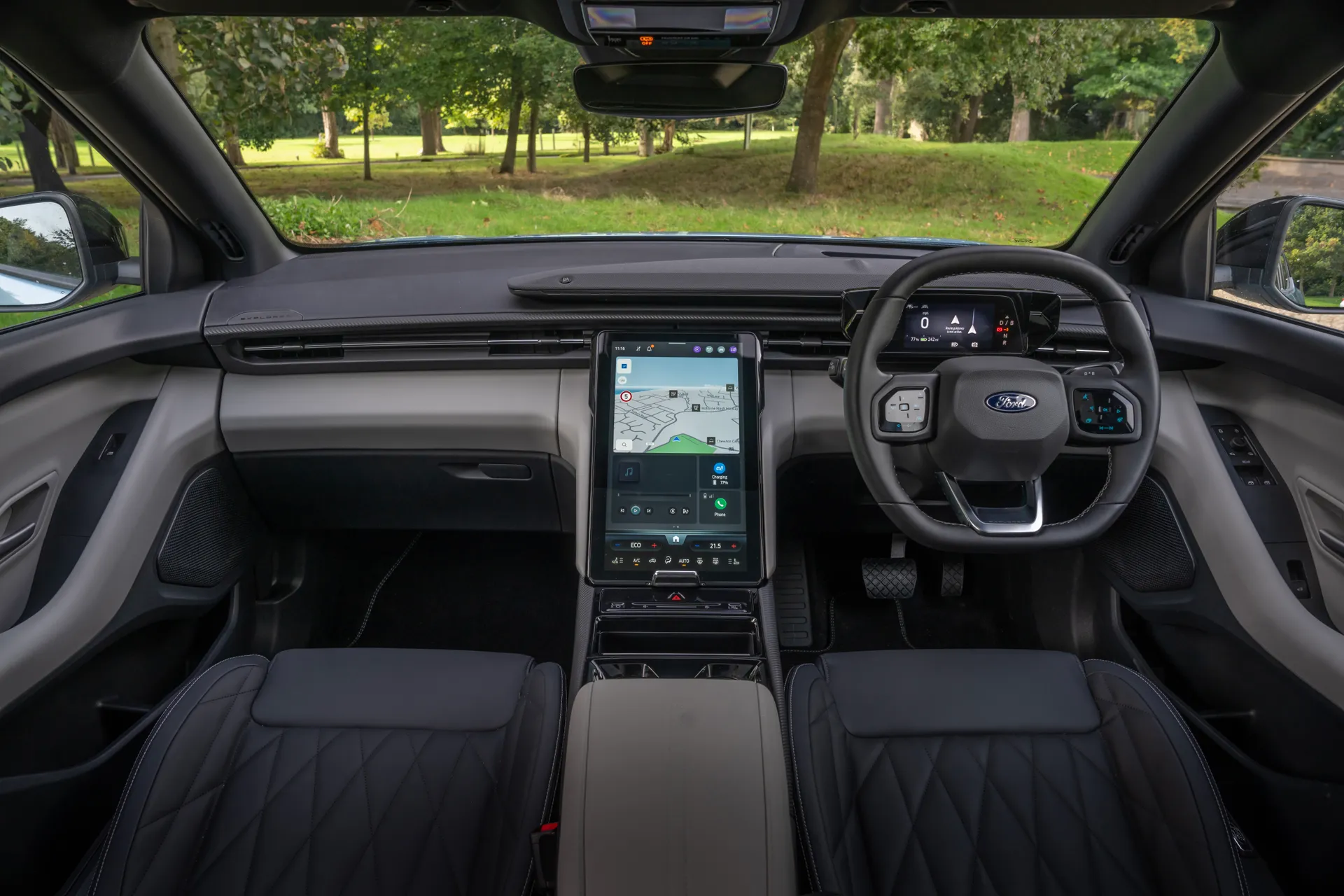
The steering wheel is manually adjustable, and while it has a decent range of movement up, down, forwards and back, one shorter colleague suggested he’d like it to come out a bit farther to feel truly at home behind the wheel. Unusually for an SUV, you feel as though you’re sat low and back — not a bad thing — so extending the wheel’s trajectory rearwards would amplify that.
Regardless of where the squared-off steering wheel is positioned, it’s easy to see the 5.0-inch driver’s display sat dead ahead of you, even though it doesn’t move up and down with the column as on VWs. Nevertheless, you can see all the info you need at a glance. The Tesla Model Y displays all the driving info on the central infotainment screen, forcing you to look away from the road for longer to see what speed you’re going.
The general seating position works mostly well, then, but the lack of physical controls is a nuisance. Instead of individual buttons are various haptic touchpads that control various elements. Trying to use them while driving is almost as distracting as trying to fiddle with the Ford Explorer’s infotainment system — we’ll get on to that a bit later.
Even the steering wheel controls are these touch-sensitive pads, technology from Volkswagen that comes with the platform. Ford’s modified them in terms of graphics and colours, but hasn’t altered their functionality. Another niggling VW carryover are the physical buttons to open and close the windows. Each door has its own individual switch, but the driver’s master panel has two buttons for all four windows.
Yes, you read that right, you use the same two window switches to operate all four windows. To go from operating the front windows to the back windows you have to press a separate touch-sensitive pad to swap the function. It’s just a needless faff and completely daft, but Ford didn’t feel it was worth the engineering cost of changing it for the Explorer.
Quality and finish
Apart from sharing a few switches with VWs, you’d struggle to know the Explorer was based on a VW when sitting inside. Just like the exterior, the styling inside is all Ford, and all the better for it to be honest.
Where the ID.3 and ID.4 are serviceable but a bit bland, the Explorer looks rather swanky, although emphasis there is more on ‘looks’ as various of the interior plastics feel like they’re designed for a car that’s priced less expensively than this. If you appreciate squidgy, squeezable dashboard and door panel finishes, the Ford’s going to disappoint.
Still, it feels soundly assembled and top-spec Premium models feel lighter and airier thanks to their two-tone grey finish and the glazed roof.
We’d say it’s at least as well made inside as the Renault Scenic, but if you truly prize interior quality, and are happy to pay for it, there are plusher alternatives. Cars such as the Audi Q4 e-tron, BMW iX1 and Volvo EX40 to name a few.
Infotainment: Touchscreen, USB, nav and stereo in the Ford Explorer
Let’s start with the good bits. We like the quality and clarity of the infotainment screen — the definition is top drawer. The graphics look super smart and, happily, there’s enough processing power to run them effectively. Mostly, when you press an icon you don’t need to wait long for the response.
The screen is truly massive. It’s a 14.6in portrait-orientated screen with a trick — you can adjust the angle by up to 30 degrees to make it easier to reach and read. Positioning it more vertically also elevates it, making it easier to see in your peripheral vision and eliminating lots of annoying reflections.
Another positive is the feature count. As standard, all Explorers have in-built connected navigation, voice activation, wireless Apple CarPlay/ Android Auto, 15-watt wireless phone charging and multiple USB-C ports front and rear.
If you like your music, the entry-level Select trim has seven speakers and a soundbar across the top of two-thirds of the dashboard to enrich your listening pleasure. If you go for the Premium trim then you get a Bang & Olufsen ten-speaker system, also with a soundbar. Does it sound amazing? That would be stretching it, but it’s at its best when you’re streaming music straight from your phone rather than listening to the radio.
This moves us onto the negatives with the infotainment system. We mentioned above that Ford’s SYNC Move software is responsive, but the user experience is terrible. Bearing in mind the screen is big enough to give your local Odeon an inferiority complex, you have to wonder why the icons are so small. And by small, some of them are pinpricks of pixels you can barely see, let alone hope to hit accurately while driving. That includes the main menu button that sits demurely at the very top of the screen.
It’s not just the tiny icons. Some of the menus are quite hard to navigate, and because there’s often no back button, it can be challenging to get back to where you were. The navigation page demonstrates just how discombobulating things can be. As we’ve said, the screen’s huge, so there’s no reason to hide information away. But that’s what Ford’s done. We couldn’t find how to bring up useful info, like the time and distance to our destination. In the end, we had to ask someone from Ford to show us. It is available – just brilliantly, and completely unnecessarily, concealed.
We’re also not entirely convinced by the Apple CarPlay connection, which seemed wholly unresponsive at times, whether connected wirelessly or via a cable. This could be due to a phone software issue, of course, but at the time of testing the same device was used in other cars without issue.
Space and practicality: Ford Explorer boot space
Space up front is plentiful. So much so, it’s highly unlikely you’ll run out of head or legroom unless you’re called Goliath. It’s quite a broad interior, too, so sitting side-by-side with a passenger will leave neither party feeling pinched.
The Explorer’s also very comfortable in the rear. There’s masses of headroom back there and enough legroom — a six-footer to sit behind someone in the front seat who’s of similar stature. It helps that there’s lots of foot space under the front seats as well.
The space for the middle rear passenger is slightly more compromised, but you’ll get three adults abreast when needed and there’s a flat floor all the way across. What’s the issue then? Just that there are cars with more rear space if you need it. The Renault Scenic has more rear legroom, as do the larger Kia EV6 and Hyundai Ioniq 5.
Then there’s the Explorer’s boot. Again, it’s fine at 470 litres and will take a couple of reasonably big suitcases or a pushchair. It also has a height-adjustable boot floor, which, if you raise it up, takes away any load lip and provides a storage space for charging cables.
The Explorer’s issue is that the Scenic’s boot is noticeably bigger at 545 litres, while the Enyaq’s has 585 litres of luggage room. The Model Y has a humongous 971-litre rear trunk – and another 117 litres in its front boot as well.
Like other MEB platform-based cars, the Explorer doesn’t have a front boot, even on rear-wheel drive-only models.
If you need to carry long loads you can drop the 60/40 split rear seats, which lie relatively flat. There’s a ski hatch in the middle, so you can accommodate long, thin loads while still being able to carry a couple of rear passengers.
Where the Ford Explorer excels is interior storage space. There are cubbies and trays and deep caverns, in all adding up to 48 litres. That includes a decent sized glovebox and a 17-litre well under the front centre armrest that Ford calls the Megaconsole.
Not only is that big enough for a laptop, clever touches allow you to remove the cupholders if you’re not using them and swap them for a tray. And remember we mentioned you can adjust the angle of the infotainment screen? Well, when you slide it up this reveals a hidden cubby for your valuables. When you get out and lock the doors it locks the screen in place to fend off ne'er-do-wells — providing you’ve already returned it to its reclined position, of course.
Handling and ride quality: What is the Ford Explorer like to drive?
"Ford’s gone its own way setting up the Explorer’s suspension. Despite sharing a VW platform, it wanted to tune it to feel more Ford-like, in other words, more agile but without sacrificing comfort. So, has it worked? Yes, to a degree. We haven’t driven the Explorer side-by-side with its VW cousins, the ID.4 and Skoda Enyaq, but it feels a bit firmer without being harsh, therefore it’s arguably a little keener to carry more speed without drama through corners."
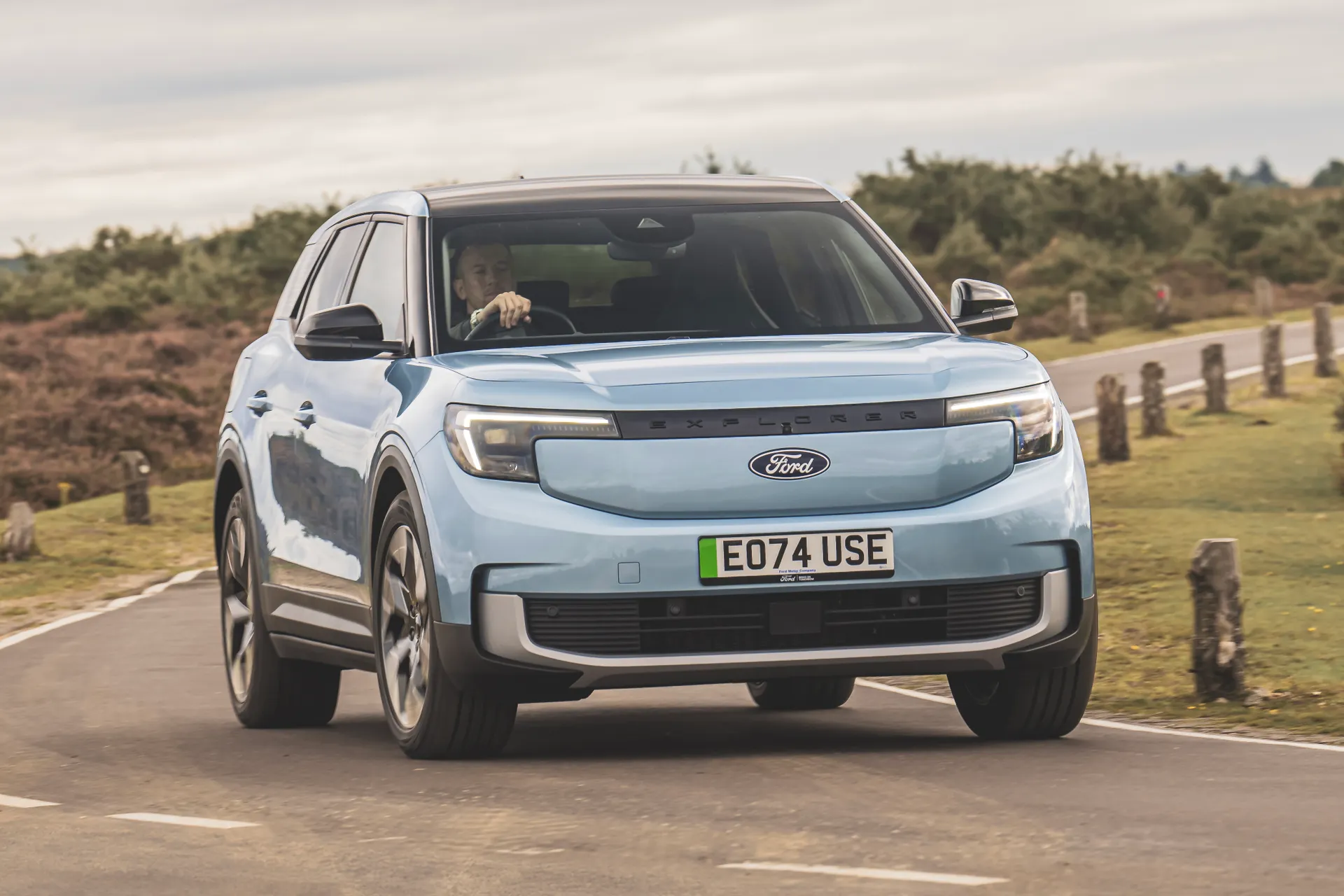
Still, that’s no bad thing. The ID.4’s effortless to drive with safe handling, and the Explorer continues in the same vein, albeit with a dash more verve. Its steering feels natural and easy to get along with, with none of the flightiness you get from the over-quick steering in the Model Y, for instance. More weight in the steering would be appreciated, though.
There’s plenty of grip, too, which feels evenly distributed between the front and rear wheels. The rear-wheel drive Extended Range punches out of corners without breaking traction too easily, allowing for swift progression away from roundabouts or tight-radius slip roads.
With all-wheel drive the Explorer feels ultra-stable and it’s the one to go for if you are likely to do any towing. At the same time, the Explorer’s tight turning circle and light steering at town speeds makes it just as confidence-inspiring to thread down narrow, city streets.
The penalty for this increased agility and firmer set-up is a jittery ride, particularly at urban speeds. On scruffy town roads strewn with potholes and surface changes, the Explorer feels agitated. It’s not harsh — it doesn’t thump or crash abruptly — but it’s more annoying on smoother, newer asphalt where minor imperfections are amplified by the Explorer’s refusal to settle down.
Increase your speed and the better it becomes, but even at motorway speeds there’s a slight fidget on seemingly smooth surfaces. Where the Ford’s at its best is on windier, more undulating A- and B-roads, being especially composed and giving the driver confidence to press on. If you value a cushy ride more than agility, we’d point you in the direction of the supple Scenic and Enyaq.
Electric cars use their brakes to regenerate energy to top up the battery when you slow down. This can make them a bit fickle and hard to judge, but not so the Explorer. The brake pedal is progressive and easy to meter, feeling barely any different to those in a combustion engine-car.
You can vary the amount of regen braking — the braking effect when you lift off the accelerator — from hardly anything to quite pronounced. The latter means you don’t have to use the brake pedal as often to slow the car down, but you don’t have the full one-pedal mode that brings you to a complete stop when you lift off, which the Model Y offers.
What motors and batteries are available in the Ford Explorer?
The cheapest Ford Explorer is the 52kWh Standard Range RWD — 52kWh denoting the usable battery capacity. It comes with a 170hp motor driving the rear wheels. Ford hasn’t released its official 0-62mph time yet but expect that to be around nine seconds.
Next up is the 77kWh Extended Range RWD. It also has a single motor driving the rear wheels but producing 286hp. 0-62mph is done in just 6.4 seconds, which is quicker than the speediest Scenic and the entry-level Model Y.
Fastest Explorer is the 79kWh Extended Range AWD. It gets two motors — the additional one driving the front wheels — with combined power of 340hp. That’s enough to make it rapid off the line: 0-62mph takes just 5.3 seconds.
Top speed is electronically limited on all Explorers at 99mph for the Standard Range and 112mph for the Extended Range versions.
Maximum electric range in the Ford Explorer
The 52kWh Standard Range Ford Explorer should manage 239 miles on a full charge, although that’s still a provisional figure. Equivalent Scenic is the Comfort Range, and with a slightly bigger 60kWh battery that’ll do up to 260 miles.
For the best battery range, you’ll need the 77kWh Extended Range RWD. Its Combined range figure is 374 miles, providing you stick with Select trim, which beats the Model Y Long Range by a healthy margin and almost matches the Scenic Long Range’s official 379 miles.
The 79kWh Extended Range AWD has the biggest battery of any Explorer but, with two motors gobbling up electricity, its official range is 329 miles.
A heat pump is optional and something we’d recommend. It’ll help maintain the battery’s range in both colder and hotter periods of the year, as well as making charging times more consistent.
Refinement and noise levels
As you’d expect from an electric car, the Ford Explorer’s eerily quiet most of the time, with barely any hum from the electric motor during everyday driving.
Even at 70mph wind and road noise are subdued and you only hear the suspension working away on really bumpy roads.
Refinement is one area where the Ford Explorer beats the Tesla Model Y hands down.
Safety equipment: How safe is the Ford Explorer?
Euro NCAP has awarded the Ford Explorer a maximum five stars for safety.
It comes with the usual gamut of safety assistance systems, including lane keeping aid, lane departure warning, traffic sign recognition, cross traffic alert and exit warning — that tells you if a cyclist is passing when you’re about to open the door. Automatic emergency braking is also standard, with its eyes looking for cars, bikes and pedestrians.
Charging times: How much does it cost to charge the Ford Explorer?
"If you have a charging stop programmed into the car’s own navigation system, the Ford Explorer will automatically get its battery in peak condition to receive the fastest charging rate possible."
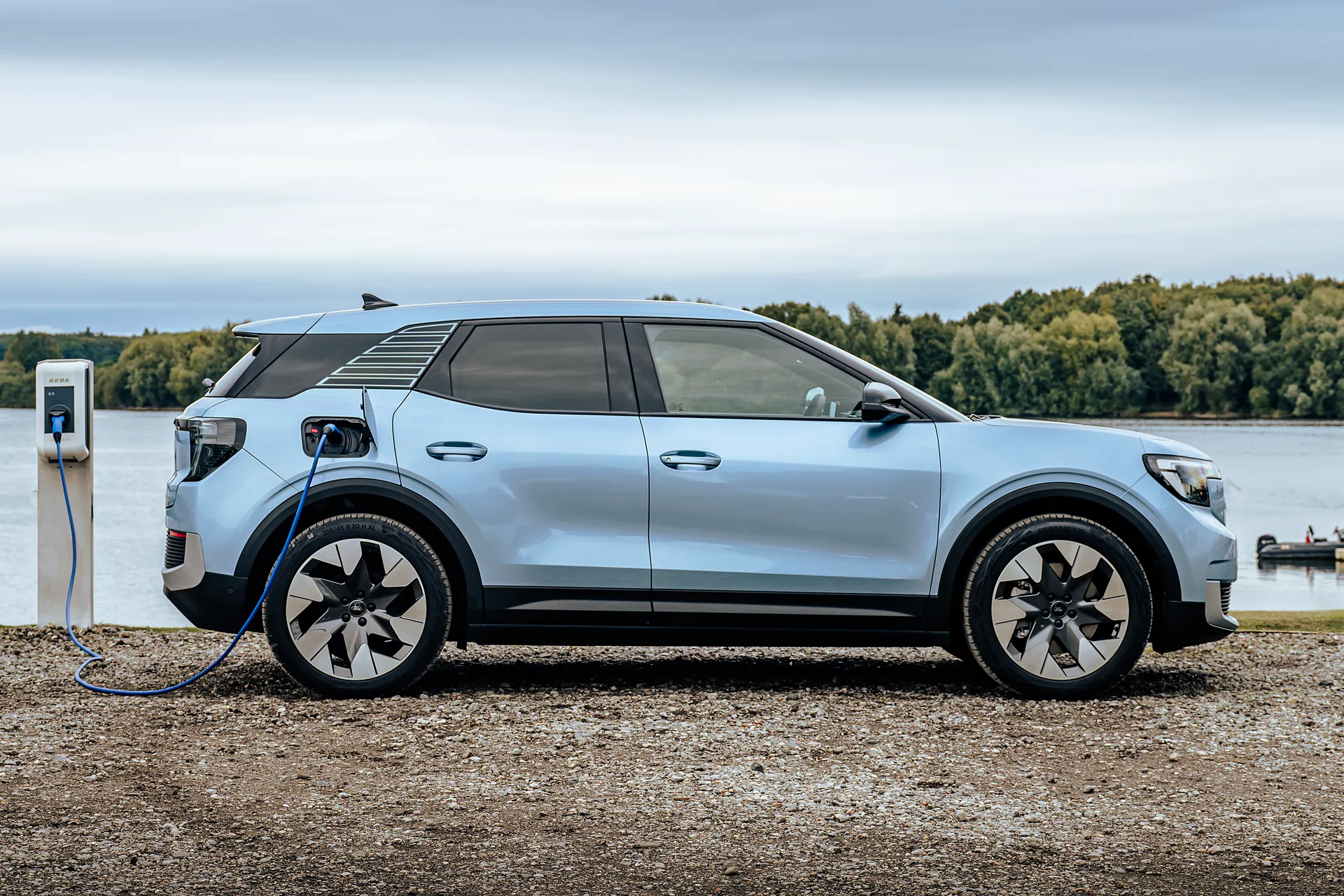
That said, if you opt for the 52kWh Standard Range RWD the maximum charging rate is at best 125kW, which is quite poor, and the 77kWh Extended Range RWD is only marginally better at 135kW. The 79kWh Extended Range AWD has a better charging speed of up to 185kW, but that’s still way off the Kia EV6’s potential 270kW.
Despite having the quickest charging speed, with its bigger battery the 79kWh Extended Range AWD doesn’t save you much fast-charging time. It recharges from 10-80 per cent in 26 minutes, while the rest of the range – with smaller batteries – recharge in 28 minutes. Again, for comparison, an EV6 takes around 18 minutes for the same gain.
If you’re charging at home from a 7.4kW wallbox you’ll need around 12 hours to take the Extended Range battery from empty to fully charged. How much is that likely to cost? If you’re using one of the cheaper off-peak tariffs to charge the 79kWh Extended Range AWD it will cost around £10. Charging the same amount at a public rapid charger could potentially cost as much as £65.
Ford Explorer reliability and warranty
The Ford Explorer is too new for us to have any hope of giving you an accurate reliability rating. But we can tell you how Ford does as a brand, and it’s not great. It managed only 23rd out of 29 places in our most recent HonestJohn.co.uk Satisfaction Index. Kia, Hyundai and Tesla finished a lot higher up the order, but Ford did better than Renault, which was last but one.
Ford’s Cologne factory where the Explorer’s made has been completely refitted for its new life as an EV plant, which could produce some niggles, as might any areas where Ford’s own software is operating through VW’s electronic hardware.
Time will tell, though, and generally speaking due to having fewer moving components, electric cars are more reliable than petrol and diesel ones as there are fewer elements to stop working.
Ford Explorer insurance groups and costs
The new Ford Explorer is in insurance groups 28 to 32 with the most affordable models also being the cheapest to insure.
VED car tax: What is the annual road tax on a Ford Explorer?
Because the Ford Explorer is all-electric, there’s some great news. You know the dreaded VED (road tax)? You don’t have to pay it — at least until April 2025 when EV exemption ends.
That exemption ending also means that electric cars will be subjected to the premium rate tax for years two to five that’s payable on all cars that have a list price, including options, in excess of £40,000. Only one Explorer is priced below that level.
Ford Explorer price
"The Ford Explorer 52kWh Standard Range in Select trim kicks off at £39,875. Compare that with the equivalent Renault Scenic Comfort Range at £37,495 and, yes, the Explorer is quite pricey."
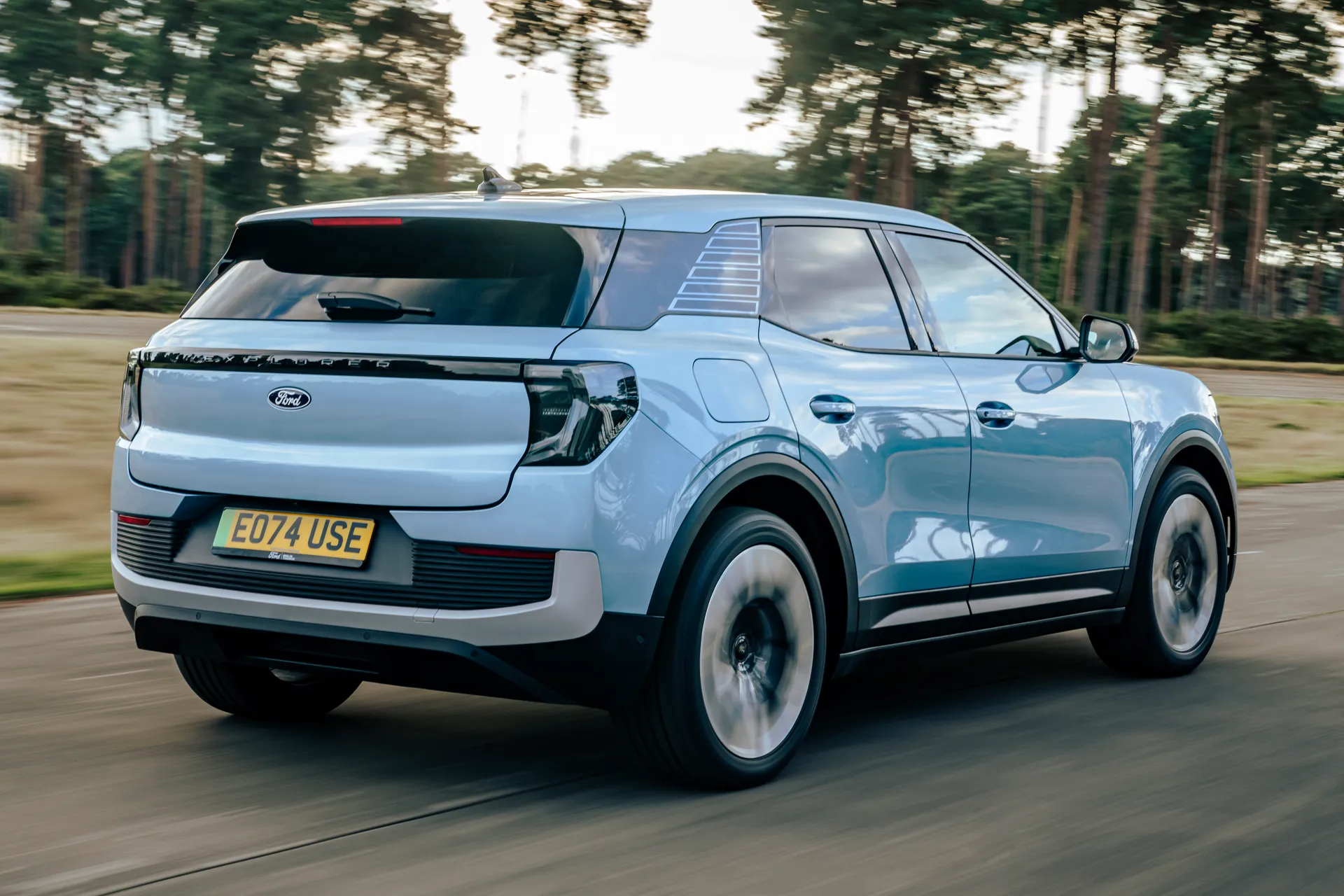
Even more so if you go for what’s likely to be the most appealing model: the 77kWh Extended Range Select RWD. That’s £45,875, and if you fancy the (top) Premium trim, get ready to shell out £49,975. Then there’s the 79kWh Extended Range AWD. You can only buy that in Premium trim, so start counting out your crisp notes to the tune of £53,975. And then bear in mind that circa £50k could bag you a Tesla Model Y Long Range AWD or a Kia EV6 AWD.
Sadly, we can’t point you in the direction of any used Explorers yet because it’s too new.
Trim levels and standard equipment
It may be expensive to buy, but at least the Ford Explorer’s two trims are very well kitted out. We’ve already mentioned some of the equipment that comes as standard on the entry-level Select trim, including wireless charging, Apple CarPlay and Android Auto with wireless function, a 14.6in infotainment screen and 5.0in driver’s display.
It also comes with 19in alloy wheels, LED headlights, LED rear lights, a 12-way electric driver’s seat with memory settings, heated front seats with massage function, darkened rear privacy glass, selectable driving modes, adaptive cruise control with stop and start function, dual-zone climate control, keyless entry, power-folding door mirrors, puddle lights, front and rear parking sensors and a rear-view camera.
Premium trim adds bigger 20in alloys, Matrix LED headlights which can stay on high beam without dazzling other road users, a powered tailgate, ambient interior lighting, a panoramic glass roof and a 10-speaker B&O sound system.
Ask the heycar experts: common questions
Is the Ford Explorer a good car?
How quick is the Ford Explorer?
How expensive is the Ford Explorer in the U.K.?
Get our latest advice, news and offers
Keep me updated by email with the latest advice, news and offers from heycar.
By submitting you agree to our privacy policy
